Our homes should be the place where we feel most calm and peace, and what better style to promote these feelings of serenity than a zen inspired space, like those featured in our Japanese Zen Gardens post and our look at Japanese Style Interior Design. In this post we're focussing not only on traditional Japanese zen, but also on its modern adaptations.
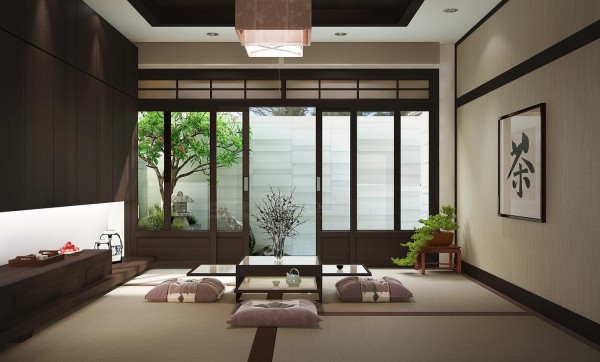
Floor cushions around a low table are an easy way to create an oriental dining zone, along with high contrast dark wood against a soothing warm cream backdrop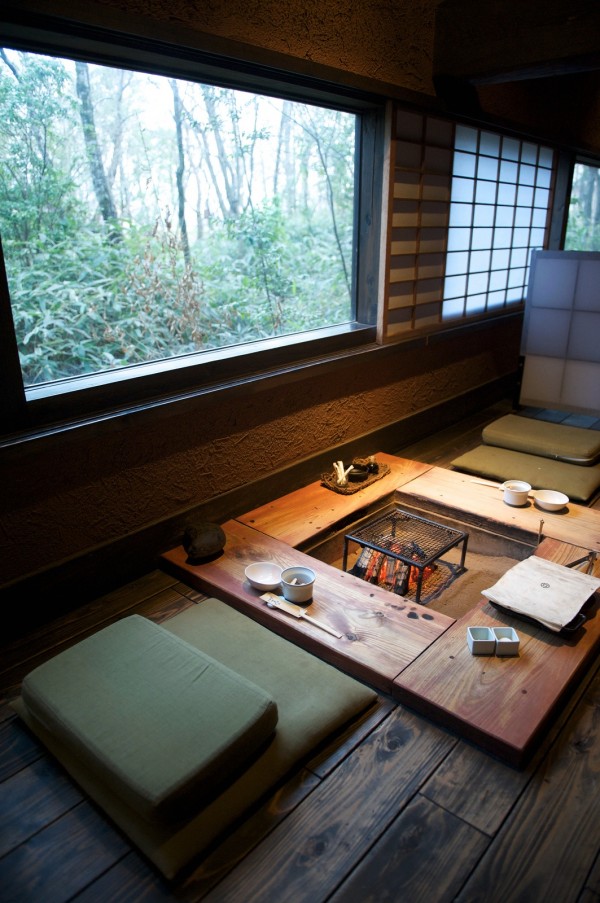
A basic sunken fire pit can keep things cozy.
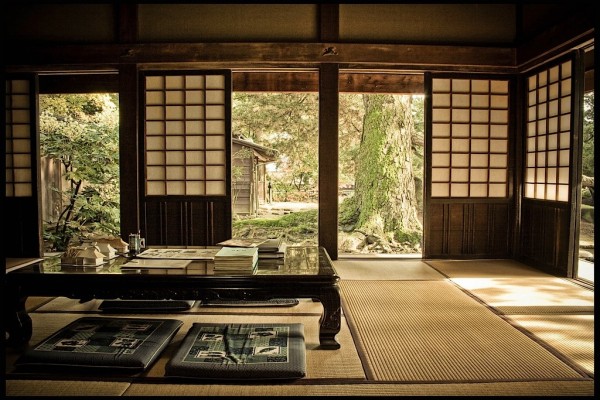 Softness underfoot creates relaxation in a zen room.
Softness underfoot creates relaxation in a zen room.
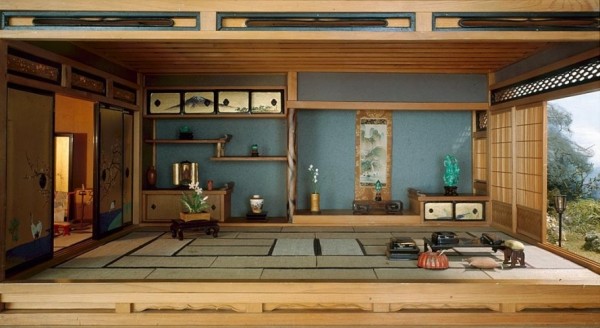
Ideally, a zen room would be free from peace disturbing electronic devices.

Traditional Japanese Home Design
The foundations for the design of today's traditional Japanese residential houses with tatami floors were established in the late Muromachi period and refined during the ensuing Momoyama period.Shoin-zukuri, a new architectural style influenced by Zen Buddhism, developed during that time from the shinden-zukuri of the earlier Heian period's palaces and the subsequent residential style favored by the warrior class during the Kamakura period.The term shoin (書院), meaning study or drawing room has been used to denote reception rooms in residences of the military elite as well as study rooms at monasteries.A shoin has a core area surrounded by aisles, and smaller areas separated by fusuma sliding doors, or shōji partitions constructed of paper on a wooden frame or wooden equivalents, mairado (舞良戸) and sugido (杉戸).The main reception room is characterized by specific features: a recessed alcove (tokonoma); staggered shelves; built-in desks; and ornate sliding doors. Generally the reception room is covered with wall-to-wall tatami, has square beveled pillars, a coved and/or coffered ceiling, and wooden shutters protecting the area from rain (雨戸 amado). Historic Monuments of Ancient Kyoto (Kyoto, Uji and Otsu Cities)
Historic Monuments of Ancient Kyoto (Kyoto, Uji and Otsu Cities)

The shoin (書院)

The reception room’s major feature is built in tokonoma – Japanese alcove, with a decorative pillar. Tokonoma is a mini gallery, a creative space where an aesthetically pleasing art work like calligraphy or painting scroll, bonsai, Japanese dolls, ceramics, ikebana or other decorative items (okimono) can be displayed.
 Traditional Japanese Architecture – Raised Floor, Square Pillars, Shoji, Garden
Traditional Japanese Architecture – Raised Floor, Square Pillars, Shoji, Garden
Contemporary architecture built in traditional Japanese style will incorporate a modern, fire resistant version of traditional materials used from prehistoric times, namely natural wood and timber (for square posts and pillars; fragments of walls, widows, gates etc). Straw (roofs of farmers houses, and for the tatami flooring).
Stone and bricked earth (for filling the foundation) are now replaced with modern concrete materials.
A variety of ceramic roofing tiles can be used to shape the roof.
Traditional Japanese architecture will include use of various kinds of resistant paper (for paper walls and sliding doors and windows).Traditional Japanese Architecture.
Bed ROOM

LIVING ROOM

KOTATSU
DINING ROOM

BATH ROOM



Floor cushions around a low table are an easy way to create an oriental dining zone, along with high contrast dark wood against a soothing warm cream backdrop

A basic sunken fire pit can keep things cozy.
 Softness underfoot creates relaxation in a zen room.
Softness underfoot creates relaxation in a zen room. 
Ideally, a zen room would be free from peace disturbing electronic devices.

Traditional Japanese Home Design
The foundations for the design of today's traditional Japanese residential houses with tatami floors were established in the late Muromachi period and refined during the ensuing Momoyama period.Shoin-zukuri, a new architectural style influenced by Zen Buddhism, developed during that time from the shinden-zukuri of the earlier Heian period's palaces and the subsequent residential style favored by the warrior class during the Kamakura period.The term shoin (書院), meaning study or drawing room has been used to denote reception rooms in residences of the military elite as well as study rooms at monasteries.A shoin has a core area surrounded by aisles, and smaller areas separated by fusuma sliding doors, or shōji partitions constructed of paper on a wooden frame or wooden equivalents, mairado (舞良戸) and sugido (杉戸).The main reception room is characterized by specific features: a recessed alcove (tokonoma); staggered shelves; built-in desks; and ornate sliding doors. Generally the reception room is covered with wall-to-wall tatami, has square beveled pillars, a coved and/or coffered ceiling, and wooden shutters protecting the area from rain (雨戸 amado).
 Historic Monuments of Ancient Kyoto (Kyoto, Uji and Otsu Cities)
Historic Monuments of Ancient Kyoto (Kyoto, Uji and Otsu Cities) 
The shoin (書院)

The reception room’s major feature is built in tokonoma – Japanese alcove, with a decorative pillar. Tokonoma is a mini gallery, a creative space where an aesthetically pleasing art work like calligraphy or painting scroll, bonsai, Japanese dolls, ceramics, ikebana or other decorative items (okimono) can be displayed.
 Traditional Japanese Architecture – Raised Floor, Square Pillars, Shoji, Garden
Traditional Japanese Architecture – Raised Floor, Square Pillars, Shoji, GardenContemporary architecture built in traditional Japanese style will incorporate a modern, fire resistant version of traditional materials used from prehistoric times, namely natural wood and timber (for square posts and pillars; fragments of walls, widows, gates etc). Straw (roofs of farmers houses, and for the tatami flooring).
Stone and bricked earth (for filling the foundation) are now replaced with modern concrete materials.
A variety of ceramic roofing tiles can be used to shape the roof.
Traditional Japanese architecture will include use of various kinds of resistant paper (for paper walls and sliding doors and windows).Traditional Japanese Architecture.
Bed ROOM

LIVING ROOM

KOTATSU
DINING ROOM

BATH ROOM


Traditional Japanese architecture made
use predominantly of wood because of the abundance of timber. Timber is
particularly resistant to natural disasters such as earthquakes. Wood
is also an ideal type of material for Japan’s humid climate. - See more
at:
http://www.kcpwindowonjapan.com/2014/12/traditional-japanese-architecture-sukiya-zukuri-and-shoin-zukuri/#sthash.MSUlcjCE.dpuf
made
use predominantly of wood because of the abundance of timber. Timber is
particularly resistant to natural disasters such as earthquakes. Wood
is also an ideal type of material for Japan’s humid climate. - See more
at:
http://www.kcpwindowonjapan.com/2014/12/traditional-japanese-architecture-sukiya-zukuri-and-shoin-zukuri/#sthash.MSUlcjCE.dpuf
 made
use predominantly of wood because of the abundance of timber. Timber is
particularly resistant to natural disasters such as earthquakes. Wood
is also an ideal type of material for Japan’s humid climate. - See more
at:
http://www.kcpwindowonjapan.com/2014/12/traditional-japanese-architecture-sukiya-zukuri-and-shoin-zukuri/#sthash.MSUlcjCE.dpuf
made
use predominantly of wood because of the abundance of timber. Timber is
particularly resistant to natural disasters such as earthquakes. Wood
is also an ideal type of material for Japan’s humid climate. - See more
at:
http://www.kcpwindowonjapan.com/2014/12/traditional-japanese-architecture-sukiya-zukuri-and-shoin-zukuri/#sthash.MSUlcjCE.dpuf
Traditional Japanese architecture made
use predominantly of wood because of the abundance of timber. Timber is
particularly resistant to natural disasters such as earthquakes. Wood
is also an ideal type of material for Japan’s humid climate. - See more
at:
http://www.kcpwindowonjapan.com/2014/12/traditional-japanese-architecture-sukiya-zukuri-and-shoin-zukuri/#sthash.MSUlcjCE.dpuf
made
use predominantly of wood because of the abundance of timber. Timber is
particularly resistant to natural disasters such as earthquakes. Wood
is also an ideal type of material for Japan’s humid climate. - See more
at:
http://www.kcpwindowonjapan.com/2014/12/traditional-japanese-architecture-sukiya-zukuri-and-shoin-zukuri/#sthash.MSUlcjCE.dpuf
 made
use predominantly of wood because of the abundance of timber. Timber is
particularly resistant to natural disasters such as earthquakes. Wood
is also an ideal type of material for Japan’s humid climate. - See more
at:
http://www.kcpwindowonjapan.com/2014/12/traditional-japanese-architecture-sukiya-zukuri-and-shoin-zukuri/#sthash.MSUlcjCE.dpuf
made
use predominantly of wood because of the abundance of timber. Timber is
particularly resistant to natural disasters such as earthquakes. Wood
is also an ideal type of material for Japan’s humid climate. - See more
at:
http://www.kcpwindowonjapan.com/2014/12/traditional-japanese-architecture-sukiya-zukuri-and-shoin-zukuri/#sthash.MSUlcjCE.dpuf
Traditional Japanese architecture made
use predominantly of wood because of the abundance of timber. Timber is
particularly resistant to natural disasters such as earthquakes. Wood
is also an ideal type of material for Japan’s humid climate. - See more
at:
http://www.kcpwindowonjapan.com/2014/12/traditional-japanese-architecture-sukiya-zukuri-and-shoin-zukuri/#sthash.MSUlcjCE.dpuf
made
use predominantly of wood because of the abundance of timber. Timber is
particularly resistant to natural disasters such as earthquakes. Wood
is also an ideal type of material for Japan’s humid climate. - See more
at:
http://www.kcpwindowonjapan.com/2014/12/traditional-japanese-architecture-sukiya-zukuri-and-shoin-zukuri/#sthash.MSUlcjCE.dpuf
 made
use predominantly of wood because of the abundance of timber. Timber is
particularly resistant to natural disasters such as earthquakes. Wood
is also an ideal type of material for Japan’s humid climate. - See more
at:
http://www.kcpwindowonjapan.com/2014/12/traditional-japanese-architecture-sukiya-zukuri-and-shoin-zukuri/#sthash.MSUlcjCE.dpuf
made
use predominantly of wood because of the abundance of timber. Timber is
particularly resistant to natural disasters such as earthquakes. Wood
is also an ideal type of material for Japan’s humid climate. - See more
at:
http://www.kcpwindowonjapan.com/2014/12/traditional-japanese-architecture-sukiya-zukuri-and-shoin-zukuri/#sthash.MSUlcjCE.dpuf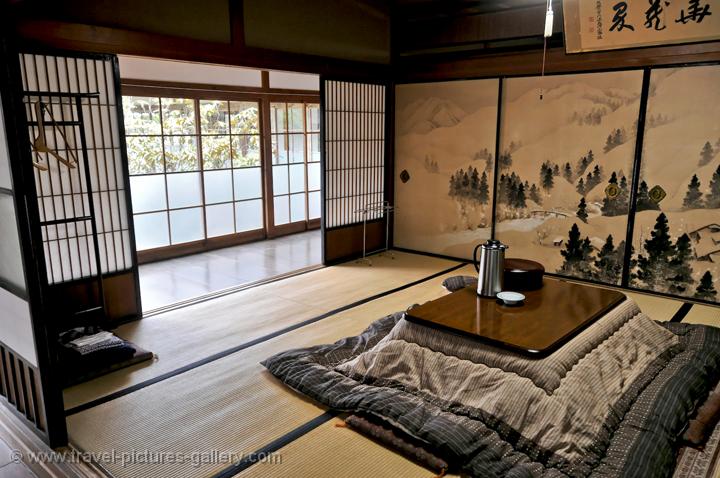
No comments:
Post a Comment